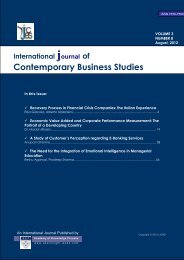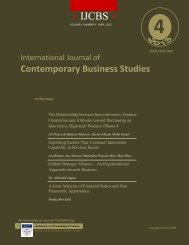Contemporary Business Studies - Academy of Knowledge Process ...
Contemporary Business Studies - Academy of Knowledge Process ...
Contemporary Business Studies - Academy of Knowledge Process ...
Create successful ePaper yourself
Turn your PDF publications into a flip-book with our unique Google optimized e-Paper software.
International Journal <strong>of</strong> <strong>Contemporary</strong> <strong>Business</strong> <strong>Studies</strong><br />
Vol: 3, No: 1. January, 2012 ISSN 2156-7506<br />
Available online at http://www.akpinsight.webs.com<br />
degree <strong>of</strong> information asymmetry and the agent costs depend on the peculiarities <strong>of</strong> every firm, such firms<br />
are more sensitive to financial factors than other. The debt limit <strong>of</strong> the firms is determined in the view,<br />
since interest payment is tax deductible, the firm prefers debt financing to equity and it would rather have<br />
an infinite amount <strong>of</strong> debt, However, this leads to negative equity value in some status so that the firm<br />
would rather go bankrupt instead <strong>of</strong> paying its debt. Therefore debt to remain risk-free, lenders will limit<br />
the amount <strong>of</strong> debt. They can limit the debt by accepting the resale value <strong>of</strong> capital as collateral and<br />
ensuring that this value is not lower than the amount <strong>of</strong> debt, so that they can recover their money in case<br />
<strong>of</strong> bankruptcy. Alternatively, lenders may limit the amount <strong>of</strong> debt in order to ensure that the marker<br />
value <strong>of</strong> equity is always non-negative and bankruptcy is sub-optimal for the firm.<br />
While there is by now a rapidly expanding literature on the presence <strong>of</strong> finance constraints on investment<br />
decisions <strong>of</strong> firms for developed countries, a limited empirical research has been forthcoming in the<br />
context <strong>of</strong> developing countries for two main reasons. (i) Until recently, the corporate sector in emerging<br />
markets encountered several constraints in accessing equity and debt markets. As a consequence, any<br />
research on the interface between capital structure <strong>of</strong> firms and finance constraints could have been<br />
largely constraint- driven and have less illuminating. (ii) Several emerging economies, even until the late<br />
1980s, suffered from financial depression, with negative real rates <strong>of</strong> interest as well as high levels <strong>of</strong><br />
statutory pre-emption. This could have meant a restricted play <strong>of</strong> market force for resource allocating.<br />
Issues regarding the interaction between financing constraint and corporate finance have, however, gained<br />
prominence in recent years, especially in the context <strong>of</strong> the fast changing institutional framework in these<br />
countries. Several emerging economies have introduced market-oriented reforms in the financial sector.<br />
More importantly the institutional set-up within which corporate houses operated in the regulated era has<br />
undergone substantial transformation since the 1990s. The moves towards market-driven allocation <strong>of</strong><br />
resources, coupled with the widening and deepening <strong>of</strong> financial market, have provided greater scope for<br />
corporate house to determine their capital structure.<br />
The rest <strong>of</strong> the paper unfolds as follows. Section II discuses the historical background <strong>of</strong> the study.<br />
Section III explains data and methodology <strong>of</strong> the paper. Section IV presents the empirical results and<br />
discusses robustness check followed by the conclusions in the final section.<br />
2. REVIEW OF LITERATURES<br />
Several authors have studied the impact <strong>of</strong> financial leverage on investment. They reached conflicting<br />
conclusions using various approaches. When we talk about investment, it is important to differentiate<br />
between overinvestment and under-investment. Modigliani and Miller (1958) argued that the investment<br />
policy <strong>of</strong> a firm should be based only on those factors that would increase the pr<strong>of</strong>itability, cash flow or<br />
net worth <strong>of</strong> a firm. Many empirical literatures have challenged the leverage irrelevance theorem <strong>of</strong><br />
Modigliani and Miller. The irreverence proposition <strong>of</strong> Modigliani and Miller will be valid only if the<br />
perfect market assumptions underlying their analysis are satisfied. However the corporate world is<br />
characterized by various market imperfections costs, institution restrictions and asymmetric information.<br />
The interaction between management, shareholders and debt holders will generate frictions due to agency<br />
problems and that may result to under-investment or over-investment incentives. As stated earlier one <strong>of</strong><br />
the main issues in corporate finance is whether financial leverage has any effects on investments policies.<br />
Myers (1977), high leverage overhang reduces the incentives <strong>of</strong> the shareholder-management coalition in<br />
control <strong>of</strong> the firm to invest in positive net present value <strong>of</strong> investment opportunities, since the benefits<br />
accrue to the bondholders rather than the shareholders thus, highly levered firm are less likely to exploit<br />
valuable growth opportunities as compared to firm with low levels <strong>of</strong> leverage a related under investment<br />
theory centers on a liquidity affect in that firm with large debt commitments invest less no matter what<br />
their growth opportunities. Theoretically, even if leverage creates potential underinvestment incentives,<br />
36<br />
Copyright © 2012. <strong>Academy</strong> <strong>of</strong> <strong>Knowledge</strong> <strong>Process</strong>
















